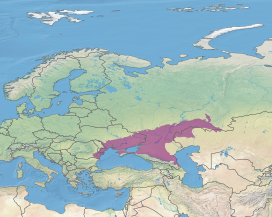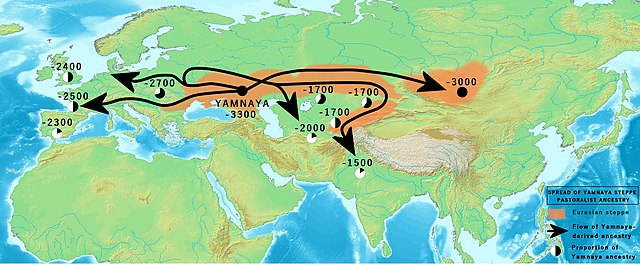Loading AI tools
One of the Eurasian steppes From Wikipedia, the free encyclopedia
The Pontic–Caspian Steppe is a steppe extending across Eastern Europe to Central Asia, formed by the Caspian and Pontic steppes. It stretches from the northern shores of the Black Sea (the Pontus Euxinus of antiquity) to the northern area around the Caspian Sea, where it ends at the Ural-Caspian narrowing, which joins it with the Kazakh Steppe in Central Asia, making it a part of the larger Eurasian Steppe. Geopolitically, the Pontic-Caspian Steppe extends from northeastern Bulgaria and southeastern Romania through Moldova and eastern Ukraine, through the North Caucasus of southern Russia, and into the Lower Volga region where it straddles the border of southern Russia and western Kazakhstan. Biogeographically, it is a part of the Palearctic realm, and of the temperate grasslands, savannas, and shrublands biome.
| Pontic–Caspian steppe | |
|---|---|
 The steppe in Azov-Syvash National Nature Park, Ukraine, with reintroduced horses. | |
 The steppe extends roughly from the Danube to the Ural River. In this map is shown the region known as Pontic Steppe, which is the biggest portion of the whole Pontic-Caspian Steppe. | |
| Ecology | |
| Realm | Palearctic |
| Biome | Temperate grasslands, savannas, and shrublands |
| Borders | |
| Geography | |
| Area | 994,000 km2 (384,000 sq mi) |
| Countries | |


The area corresponds to Cimmeria, Scythia, and Sarmatia of classical antiquity. Across several millennia, numerous tribes of nomadic horsemen used the steppe; many of them went on to conquer lands in the settled regions of Central and Eastern Europe, West Asia, and South Asia.
The term Ponto-Caspian region is used in biogeography with reference to the flora and fauna of these steppes, including animals from the Black, Caspian, and Azov Seas. Genetic research has identified this region as the most probable place where horses were first domesticated.[1] The Kurgan hypothesis, the most prevalent theory in Indo-European studies, speculates that the Pontic–Caspian steppe was the homeland of the speakers of the Proto-Indo-European language.[2][3][4][5] With the scientific advances in DNA genome mapping and the introduction of bioarchaeology, the Kurgan hypothesis is today widely considered to have been validated.[6][7][8]
The Pontic–Caspian steppe covers an area of 994,000 km2 (384,000 sq mi) of Central and Eastern Europe, that extends from northeastern Bulgaria and southeastern Romania, through Moldova, and southern and eastern Ukraine, through the Northern Caucasus of southern Russia, and into the Lower Volga region of western Kazakhstan, to the east of the Ural Mountains. The steppe is bounded by the East European forest steppe to the north, a transitional zone of mixed grasslands and temperate broadleaf and mixed forests.
To the south, the steppe extends to the Black Sea, except the Crimean and western Caucasus mountains' border with the sea, where the Crimean Submediterranean forest complex defines the southern edge of the steppes. The steppe extends to the western shore of the Caspian Sea in the Dagestan region of Russia, but the drier Caspian lowland desert lies between the steppe and the northwestern and northern shores of the Caspian. The Kazakh Steppe bounds the steppe to the east.
The Ponto-Caspian seas are the remains of the Turgai Sea, an extension of the Paratethys which extended south and east of the Urals and covering much of today's West Siberian Plain in the Mesozoic and Cenozoic.



Seamless Wikipedia browsing. On steroids.
Every time you click a link to Wikipedia, Wiktionary or Wikiquote in your browser's search results, it will show the modern Wikiwand interface.
Wikiwand extension is a five stars, simple, with minimum permission required to keep your browsing private, safe and transparent.